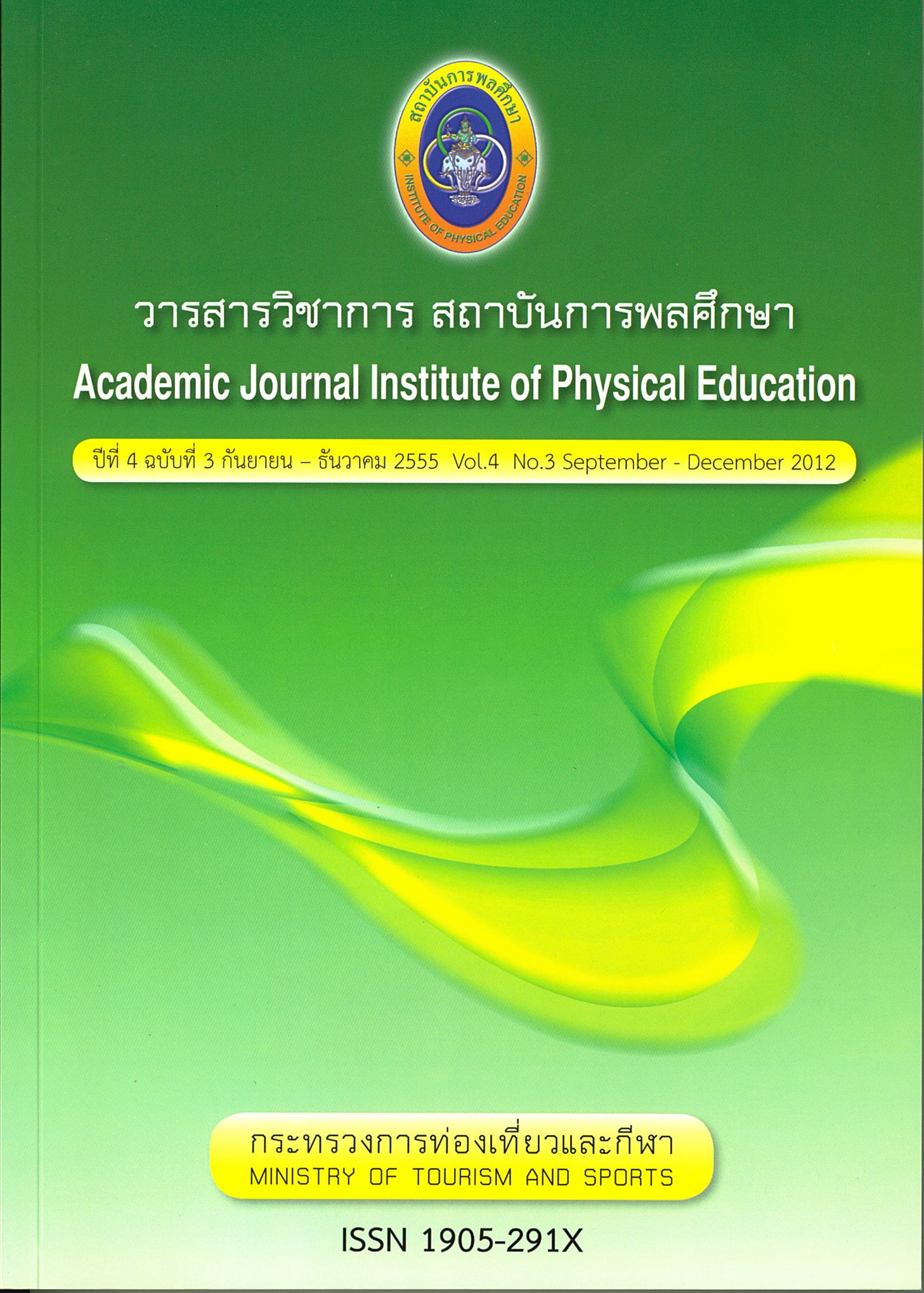A Comparision Between The Effect of Arerobic and Anaerobic Traning on Anaerobic Threshold In Eighteen Years Old Soccer Player
Main Article Content
Abstract
The anaerobic threshold is an important factor for improving cardiovascular system and reduce fatigue caused by lactic acid. The athlete must have high endurance of the cardiovascular system so as to use more efficiently and to extend the onset of the anaerobic threshold
Purpose The purpose of the study was to study and to make a comparison between the effect of aerobic and anaerobic training on anaerobic threshold (ANT) in eighteen years old soccer player.
Methods The samples were purposively random sampled to be 24 eighteen year old soccer players of Bangkok Christian College team. The samples were then randomized to be 12 subject in 2 groups for the different program training. One group was trained with aerobic training program and the other group was trained with the anaerobic training program. Each group was trained for 2 days a week with 30 minutes a day. The researcher examined the maximal oxygen consumption and the Ant by using gas analysis and V-slope method before training and after 4 week and 8 weeks of training. The obtained data were analyzed in term of means, standard deviation, t-test independent and one-way analysis of variance with repeated measures. If there were any significant differences, then the data were compared by pair using LSD method at the statistical significant level of p<.05.
Results After 8 weeks ,the aerobic training group showed significantly increased in maximal oxygen consumption (p<.05). After 4 weeks and 8 weeks, the anaerobic training
group showed significantly difference in heart rate and oxygen consumption at AnT and maximal oxygen consumption (p<.05). After 4 weeks and 8 weeks ,the anaerobic training group showed significantly increased in heart rate and oxygen consumption at AnT than the aerobic training group (p<.05). After 8 weeks, the aerobic training group showed significantly increase in maximal oxygen consumption than the anaerobic training group (p<.05).
Conclusion The anaerobic training could increase Ant better than the aerobic training
Article Details
The published article is a copyright of the Academic Journal of Thailand National Sports University. The passage appeared in each article in this academic journal is a perspective of each author which is not related to the journal. Each author is required to be responsible for all components of his/her own article. If there are any mistakes, each author must be responsible for those mistakes on his/her own.
References
ประทุม ม่วงมี, รากฐานทางสรีรวิทยาของการออกกําลังกายและการกีฬา, กรุงเทพมหานคร: สํานักพิมพ์บูรพาสาส์นม 2527.
โรม วงศ์ประเสริฐ. การพัฒนาโปรแกรมการฝึก เพื่อพัฒนาจุดเริ่มล้าในนักวิ่งระยะ 1500 เมตร. วิทยานิพนธ์ปริญญาดุษฎีบัณฑิต, ภาควิชาพลศึกษา คณะครุศาสตร์ จุฬาลงกรณ์มหาวิทยาลัย, 2545.
สนธยา สีละมาด. หลักการฝึกกีฬาสําหรับผู้ฝึกสอนกีฬา, กรุงเทพมหานคร : โรงพิมพ์แห่งจุฬาลงกรณ์มหาวิทยาลัย, 2547.
Allen, W. K.; Seals, D. R.; Hurley, B. F.; Ehsani, A. A,; and Hagberg, J M (1985). Lactate threshold and distance running performance in young and older endurance athletes. J Appl Physiol. 58: 1281 - 1284.
Bloomfield J, Polman RCJ, O'Donoghue P.G. (2007). Reliability of the Bloomfield Movement Classification. International Journal of Performance Analysis of Sport. 7(1): 20-27.
Browning, R.; and Sleamaker, R (1996). Serious Training for Endurance Athletes. Champaign, IL: Human Kinetic.
Conconi, F.; Ferrari, M.; Ziglio, P. G.; Droghetti, P.; and Codega, L (1982). Determination of the anaerobic threshold by noninvasive field test for runner. J Appl Physiol. 52 :869 - 873.
Davis, J. (2000). Anaerobic Threshold Training [online].(n.d.).Available from http://www.Doitsport.com
Krzeminski, K., Niewiadormski, W., and Nazark, K. Dynamics of Changes in The Cardio vascular Response to Submaximal Exercise during Low - Intensity Endurance Training with Particular Reference to the systolic Time Intervals. European Journal of Applied Physiology. 59 (1989) : 377-384.
Mclelian, T.M. The Significance of the Aerobic and Anaerobic Threshold for Performance and Training. Doctoral Dissertation, The University of Western Ontario, 1982. Dissertation Abstracts International. 43 - 08: 2596.
McMillan K. et al. (2005). Physiological Adaptations to Soccer Specific Endurance Training in Professional Youth Soccer Players. Br J Sports Med. 39 : 273-277
Mohr M, Krustrup P, Bangsbo J. Match performance of high-standard soccer players with special reference to development of fatigue. Journal of Sports Sciences, 2003; 21: 519-528.
Peter, R.; and Jenssen, J.M. Training Lactate Pulse Rate. Finland: Oy Litto,1992. Ready, A.E., and Qumney,H.A. Alteration in Anaerobic threshold as the Result of Endurance Training and Detraining. Medicine and Science in Sport and Exercise. 14 (April, 1982) : 296-298.
Robergs, R. A.; and Roberts, S (1997). Exercise Physiology: Exercise, performance and clinical applications. St Louis, MO: Mosby.


